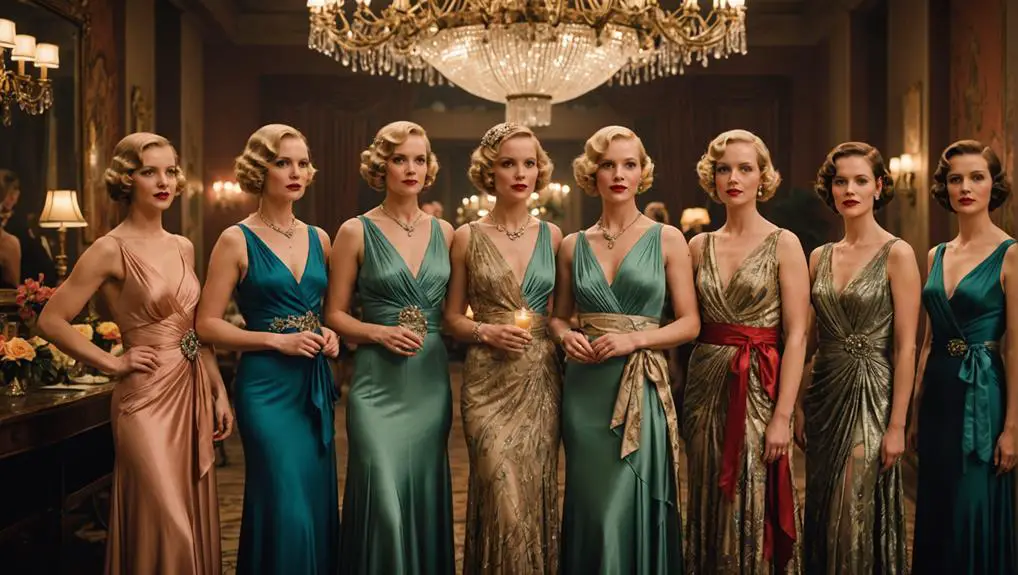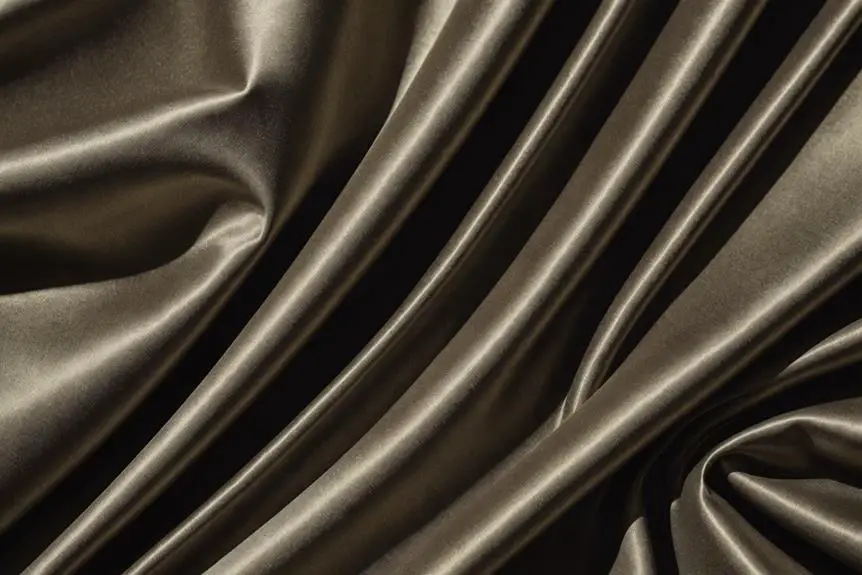In the 1930s, women's satin sashes became essential in defining elegance and flattering silhouettes. You'd see them enhancing waistlines, whether with long flowing designs or shorter belt sashes, crafted from luxurious satin, silk, or rayon. This era's muted pastels and deep hues mirrored the Art Deco movement's emphasis on opulence and geometric forms. Popular fashion icons like Greta Garbo and Claire McCardell showcased these sashes, solidifying their status. Adornments like embroidery and bows elevated their appeal. As you explore further, you'll uncover how these sashes influenced modern fashion, continuing to resonate in today's styles.
Historical Significance of Satin Sashes
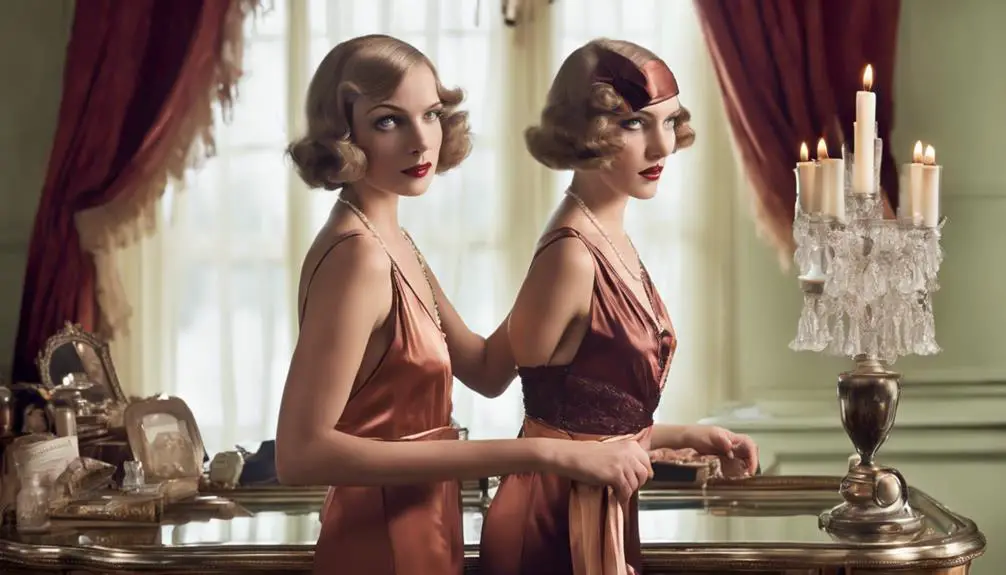
In the domain of 1930s fashion, satin sashes played a crucial role in defining women's silhouettes and enhancing their elegance. These luxurious accessories were fundamental in accentuating the waistline, reflecting the era's focus on femininity. Crafted from rich materials like silk and satin, sashes varied considerably, from simple ties to elaborate bows, showcasing the meticulous craftsmanship of the time.
The popularity of contrasting colors in satin sashes allowed women to personalize their outfits, whether for evening events or casual outings. This versatility made them a key accessory in women's fashion, seamlessly integrating into both formal and informal styles. You could easily transform a simple dress into a stunning ensemble with the right satin sash, emphasizing your figure and adding a touch of sophistication.
Moreover, the rise of satin sashes coincided with the broader Art Deco movement, which celebrated opulence and geometric forms. This connection highlighted the intricate detailing characteristic of the period, making satin sashes not just accessories but essential components of the overall aesthetic. Consequently, satin sashes hold historical significance, symbolizing the elegance and innovation of 1930s women's fashion.
Popular Styles and Designs
Satin sashes of the 1930s boasted a variety of styles and designs that showcased their versatility as fashion accessories. These sashes were integral decorative elements in both day and evening dresses, enhancing silhouettes with their luxurious sheen. You'd often see long, flowing sashes tied under the bust, creating an elegant drape that emphasized the waistline. Shorter belt sashes, sometimes adorned with buckles or bows, provided a chic alternative, further accentuating curves and adding a playful touch to outfits.
Color trends during this period ranged from muted pastels to striking hues like burgundy and deep blue, reflecting the era's sophisticated aesthetic. Often made from the same fabric as the dress, satin sashes guaranteed a cohesive look that harmonized with the overall design. Embellishments such as embroidery or contrasting trims were frequently incorporated, elevating the sashes from mere accessories to standout features.
In the 1930s, satin sashes became essential in fashion, influencing modern trends and remaining a celebrated element in today's designs. Their ability to transform both casual and formal attire continues to resonate, illustrating the timeless appeal of these enchanting accessories.
Materials Used in Production

During the 1930s, a wide range of materials contributed to the creation of women's satin sashes, with luxurious satin being the most prominent choice. This material offered a smooth, glossy finish and an elegant drape, making it ideal for the fashionable evening and wedding gowns of the era. You'd often see satin in rich hues like burgundy and deep blue, alongside pastel shades that added a touch of softness. The craftsmanship of the time was reflected in the vintage clothing trends by era, showcasing how designers utilized materials to create stunning pieces that defined the decade.
Craftsmanship was key during this time, as production techniques included bias cut, allowing the sashes to flow gracefully and fit beautifully. Satin was sometimes blended with other materials, such as silk or rayon, enhancing durability and comfort without sacrificing aesthetic appeal.
To elevate the sashes further, decorative elements were frequently incorporated. You'd find embroidered motifs and contrasting trims that reflected the fashion trends of the 1930s, showcasing intricate workmanship. This attention to detail not only emphasized the beauty of the sashes but also highlighted the skill of the artisans creating them. Overall, the materials and techniques used in the production of satin sashes contributed considerably to their allure and prominence in women's fashion during the decade.
Role in Women's Fashion
Women's satin sashes played a pivotal role in shaping the fashion landscape of the 1930s, enhancing the silhouette of dresses while emphasizing the waistline. These luxurious accessories were essential for both casual and formal attire, reflecting the era's shift towards sophistication and glamour. Designers cleverly incorporated satin sashes into women's dresses, often placing them under the bust or at the waist to create a flattering shape that complemented the popular bias-cut styles of the time.
The craftsmanship of these sashes, frequently adorned with bows or intricate knots, showcased the attention to detail characteristic of 1930s fashion. Made from rich, vibrant materials like silk and satin, they added a touch of elegance and refinement, with colors such as deep burgundy, navy, and classic black dominating eveningwear.
As you explore the fashion trends of this decade, you'll notice how satin sashes not only enhanced the aesthetic appeal of women's dresses but also marked an era of artistic expression influenced by Art Deco. Their versatility allowed women to personalize their outfits, making satin sashes an indispensable element of 1930s fashion.
Accessories Complementing Satin Sashes
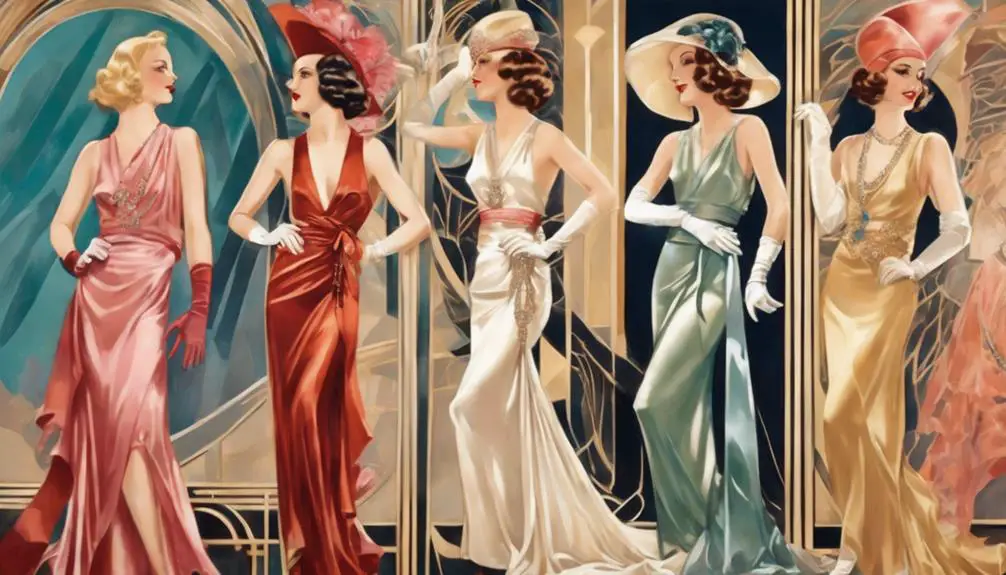
The elegance of a satin sash isn't complete without the right accessories to complement its charm. In the 1930s, these accessories played a pivotal role in enhancing the overall sophistication of women's fashion. By carefully selecting your accessories, you could elevate your look to new heights.
- Brooches: Used to fasten or embellish satin sashes, they added a touch of elegance and personality.
- Matching Gloves: Typically made from silk or satin, these were essential for formal occasions, creating a cohesive and refined appearance.
- Handbags: Often crafted from satin or embellished with beads, handbags coordinated beautifully with satin sashes, enhancing the sophistication of eveningwear.
- Footwear: Satin or silk pumps featuring decorative elements like bows aligned perfectly with the luxurious aesthetic of satin sashes.
Jewelry also played a significant part in this ensemble. Long strand pearls and art deco pieces were frequently worn, tying the entire look together with a glamorous flair. By thoughtfully combining these accessories with your satin sash, you embraced the quintessential elegance of the 1930s, making a striking statement at any occasion.
Notable Fashion Icons of the Era
As the 1930s ushered in a new era of elegance and sophistication, influential fashion icons emerged, shaping the landscape of women's attire. Hollywood stars like Greta Garbo epitomized glamour, often donning elegant gowns adorned with satin sashes that accentuated their silhouettes and enhanced their allure. The flowing lines created by these sashes contributed greatly to the romantic aesthetic of the decade.
Fashion designer Madeleine Vionnet played a pivotal role in this movement, popularizing the bias cut, which allowed satin sashes to flow gracefully, embodying femininity and fluidity. This innovation made its way into the wardrobes of many, promoting a more relaxed yet refined style.
Claire McCardell, another notable designer, revolutionized women's fashion with her casual-chic approach, incorporating satin sashes into everyday wear, breaking the mold of conventional elegance. Meanwhile, costume designer Adrian crafted stunning satin dresses for stars like Joan Crawford, emphasizing dramatic eveningwear that captivated audiences.
The satin sashes of the 1930s were not merely accessories; they represented a luxurious lifestyle influenced by the Art Deco movement, showcasing geometric patterns and sumptuous fabrics that defined the era's fashion landscape.
Influence on Modern Fashion
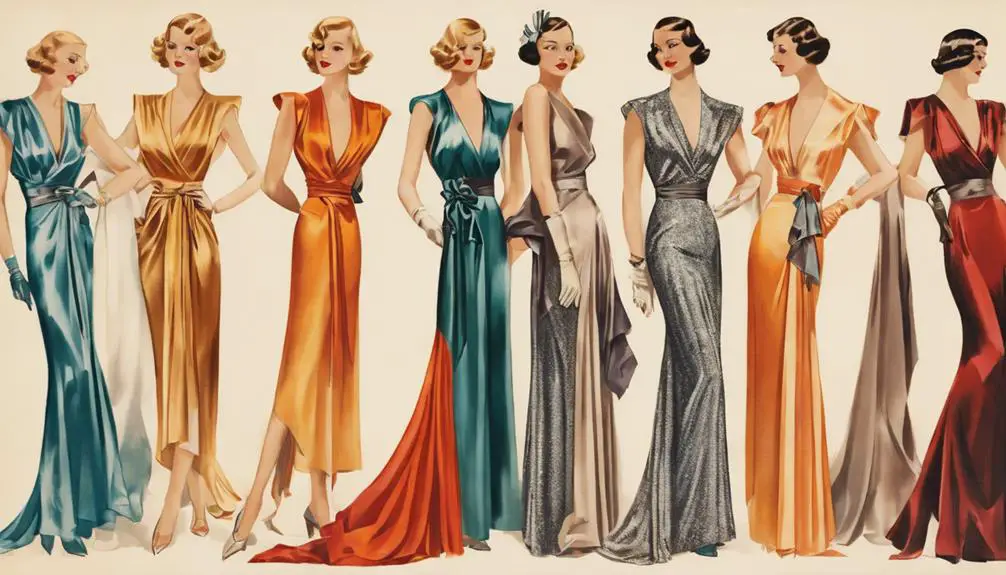
Satin sashes from the 1930s have left a lasting imprint on modern fashion, seamlessly merging vintage elegance with contemporary style. Their luxurious fabrics and intricate designs have inspired today's fashion designers to reintroduce these elements into modern garments. You'll notice that the emphasis on accentuating the waistline, a hallmark of 1930s eveningwear, remains prevalent in collections, particularly in satin dresses that flatter your figure.
Consider these modern interpretations of 1930s satin sashes:
- Bold color palettes reminiscent of vintage satin
- Intricate embellishments that add a touch of glamour
- Sashes as statement accessories in bridal and evening attire
- A revival of vintage styles celebrated by enthusiasts and reenactors alike
As you explore contemporary styles, you'll find that satin wedding dresses often incorporate sashes that echo the craftsmanship and aesthetic of the past. This revival not only celebrates history but also allows you to express your individuality, blending classic charm with modern sensibilities. Embracing these influences, you can create unique looks that pay homage to the elegance of the 1930s while remaining firmly rooted in today's fashion landscape.
Care and Preservation Tips
Preserving the beauty of 1930s satin sashes requires careful attention to their storage and maintenance. To maintain the integrity of these delicate fabrics, store them in a cool, dry place, away from direct sunlight. Sunlight can cause fading and deterioration, compromising their vibrant colors. Wrap each satin sash in acid-free tissue paper to absorb moisture and prevent creasing. This simple step notably aids in the long-term preservation of your sashes.
When it comes to cleaning, always opt for gentle methods. Spot clean with a mild detergent and cold water, steering clear of harsh chemicals that might damage the satin. Regular inspections are essential; check your stored sashes for any signs of mold or pest infestations. Verify they're properly ventilated and moisture-free.
If you choose to display your satin sashes, use padded hangers to maintain their shape and prevent unnecessary stretching. By following these care and preservation tips, you'll not only safeguard your sashes but also guarantee that they remain a reflection of the elegance of the 1930s for years to come. Your attention to detail will keep their charm alive, allowing you to enjoy these vintage treasures fully.
Where to Find Vintage Sashes

Searching for vintage sashes from the 1930s can be an exciting journey into the past, offering a unique glimpse into the fashion of that era. To uncover the perfect satin vintage piece, consider exploring various venues that specialize in antique and vintage fashion. Here are some great places to start your search:
- Antique shops: These often house a treasure trove of historical apparel, including satin sashes from the 1930s.
- Vintage boutiques: Look for shops that curate collections specifically from this decade; you might find a stunning piece that captures the essence of the time.
- Online marketplaces: Websites like Etsy and eBay frequently list vintage sashes, showcasing a range of styles and colors, typically priced between $25 and $200.
- Auctions and estate sales: Keep an eye out for unique opportunities to acquire rare or one-of-a-kind satin sashes, often available at competitive prices.
Frequently Asked Questions
How Did Societal Changes Influence Satin Sash Designs in the 1930s?
Societal changes shifted preferences towards practicality and elegance. You'll notice designs reflecting newfound freedoms, as women sought styles that combined sophistication with ease. This blend of function and fashion redefined aesthetics and cultural identity during that era.
What Colors Were Most Popular for Satin Sashes During This Era?
During this era, you'll find that vibrant colors like deep reds, blues, and greens dominated satin sash designs. These hues reflected a blend of elegance and boldness, emphasizing the fashion trends and cultural moods of the time.
Were There Any Notable Designers Specializing in Satin Sashes in the 1930s?
You'll find that several notable designers emerged in the 1930s, emphasizing elegance and sophistication. Their innovative approaches to fabric and design transformed satin sashes into statement pieces, enchanting fashion enthusiasts and setting trends that influenced future styles.
How Did Satin Sashes Differ Across Various Cultures in the 1930s?
Satin sashes varied greatly across cultures in the 1930s, reflecting unique traditions and aesthetics. You'd notice vibrant colors and intricate patterns in some regions, while others embraced minimalism, showcasing distinct cultural identities through fabric and design choices.
What Occasions Were Satin Sashes Most Commonly Worn for in the 1930s?
You'll find satin sashes commonly worn for formal events, weddings, and parties during the 1930s. They added elegance to outfits, enhancing the wearer's silhouette while reflecting status and fashion trends of that vibrant era.
